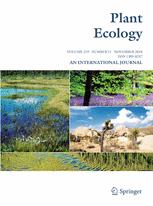Ver ítem
- xmlui.general.dspace_homeCentros e Institutos de InvestigaciónCIRN. Centro de Investigaciones de Recursos NaturalesInstituto de Recursos BiológicosArtículos científicosxmlui.ArtifactBrowser.ItemViewer.trail
- Inicio
- Centros e Institutos de Investigación
- CIRN. Centro de Investigaciones de Recursos Naturales
- Instituto de Recursos Biológicos
- Artículos científicos
- Ver ítem
The dynamics of three shrub species in a fire-prone temperate savanna: the interplay between the seed bank, seed rain and fire regime
Resumen
A model was developed to assess how the seed rain and fire regime affect seed bank dynamics and seedling establishment of three native shrub species (Acanthostyles buniifolius, Baccharis pingraea and Baccharis dracunculifolia) with different regeneration strategies, in temperate South American savanna. Seed bank and seed rain were quantified for each species under different fire regimes, and their relative roles in regeneration were evaluated. All species
[ver mas...]
A model was developed to assess how the seed rain and fire regime affect seed bank dynamics and seedling establishment of three native shrub species (Acanthostyles buniifolius, Baccharis pingraea and Baccharis dracunculifolia) with different regeneration strategies, in temperate South American savanna. Seed bank and seed rain were quantified for each species under different fire regimes, and their relative roles in regeneration were evaluated. All species had short-term persistent seed banks and high annual variability in seed production. A high proportion of seeds deposited in the seed rain produced seedlings after fire; few entered the soil seed bank. Fire killed a high proportion of the seeds in the soil seed bank. Seedlings derived from the seed rain had a higher probability of surviving for 2 years than seedlings emerging from the soil seed bank. In the absence of fire, establishment depended on germination both from the seed rain and the soil seed bank, whereas with annual fire, establishment was primarily dependent on germination of seeds arriving in the annual seed rain, regardless of species’ regeneration strategies. These results help to explain changes in the vegetation of South American temperate savannas as a result of changes in fire regime and grazing management during the last 50 years. By revealing the crucial roles of the soil seed bank and seed rain in regeneration, this study provides vital information for the development of appropriate management practices to control populations of shrub species with different regeneration strategies in South American temperate savannas.
[Cerrar]

Autor
Galindez, Guadalupe;
Ortega Baes, Francisco Pablo;
Scopel, Ana Leonor;
Hutchings, Michael J.;
Fuente
Plant Ecology 214 (1) : 75–86 (January 2013)
Fecha
2013-01
Editorial
Springer
ISSN
1385-0237
1573-5052
1573-5052
Formato
pdf
Tipo de documento
artículo
Palabras Claves
Derechos de acceso
Restringido
 Excepto donde se diga explicitamente, este item se publica bajo la siguiente descripción: Creative Commons Attribution-NonCommercial-ShareAlike 2.5 Unported (CC BY-NC-SA 2.5)
Excepto donde se diga explicitamente, este item se publica bajo la siguiente descripción: Creative Commons Attribution-NonCommercial-ShareAlike 2.5 Unported (CC BY-NC-SA 2.5)

